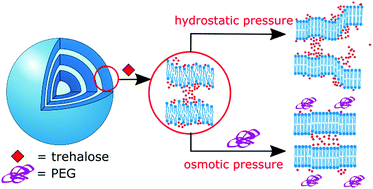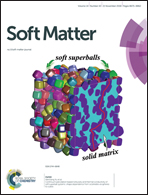Combined effects of osmotic and hydrostatic pressure on multilamellar lipid membranes in the presence of PEG and trehalose†
Abstract
We studied the interaction of lipid membranes with the disaccharide trehalose (TRH), which is known to stabilize biomembranes against various environmental stress factors. Generally, stress factors include low/high temperature, shear, osmotic and hydrostatic pressure. Small-angle X-ray-scattering was applied in combination with fluorescence spectroscopy and calorimetric measurements to get insights into the influence of trehalose on the supramolecular structure, hydration level, and elastic and thermodynamic properties as well as phase behavior of the model biomembrane DMPC, covering a large region of the temperature, osmotic and hydrostatic pressure phase space. We observed distinct effects of trehalose on the topology of the lipid's supramolecular structure. Trehalose, unlike osmotic pressure induced by polyethylene glycol, leads to a decrease of lamellar order and a swelling of multilamellar vesicles, which is attributable to direct interactions between the membrane and trehalose. Our results revealed a distinct biphasic concentration dependence of the observed effects of trehalose. While trehalose intercalates between the polar head groups at low concentrations, the effects after saturation are dominated by the exclusion of trehalose from the membrane surface.



 Please wait while we load your content...
Please wait while we load your content...